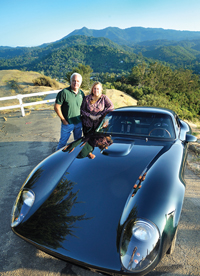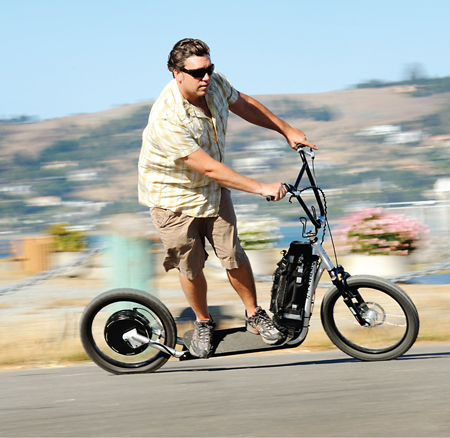Although their engines make very little noise, a roar of activity and excitement is building around electric vehicles, and if you follow the charging cord, you’ll see that it connects to the tech-savvy, envelope-pushing Bay Area.
“We are about to hit the tipping point of public acceptance and vehicle accessibility,” says San Rafael resident Dale Miller, president of the San Francisco Electric Vehicle Association and curator of the Electric Wheels car show at the Marin County Fair earlier this year. “It will be like seeing a Prius used to be—you’ll be parking next to them soon.”
And while extended-range vehicles like the Chevy Volt, which promises an estimated 230 miles per gallon, are exciting, Miller says new all-electric vehicles like the Nissan Leaf, which Nissan announced at an SFEVA meeting hours before the world heard about it, are the real future. They have zero emissions, they’re low-maintenance and quiet in operation, they use no foreign oil, and they facilitate load balancing on the power grid.
It is this last part that excites Richard Schorske, Climate Action Director at the Marin Climate and Energy Partnership, a collaboration between Marin’s cities, agencies and authorities to reduce greenhouse gas emissions in alignment with California’s AB32. “E.V.s can store excess power and wind energy,” he says, referring to a new smart grid technology that would move energy to and from electric vehicles. “It is extremely cost-effective to store energy in electric vehicle batteries at night when wind production is at its greatest. We are desperate for more storage capacity.”
Both Schorske and Miller think we’ll begin to see these new cars starting in 2010 when the Volt and the Leaf join the Bay Area–made Tesla on the road. Schorske is also hopeful that we’ll begin to see charging stations shortly after that, as Marin County is under consideration to receive $1 million in federal funds to build more than 100 of these stations.
Both agree that full-function, affordable and highway-ready vehicles will make the difference when they hit the streets next year. Indeed, the number-one question asked at the fair auto show this year was “How do I get one?” A few Marin residents already have some ideas.
The Raptor
 One of the vehicles that really stole the show at the county fair this year was the all-electric Raptor, a replica of a 1965 Daytona Coupe, built in San Rafael in 2006.
One of the vehicles that really stole the show at the county fair this year was the all-electric Raptor, a replica of a 1965 Daytona Coupe, built in San Rafael in 2006.
“Gas prices were going up and Detroit was refusing to make anything economically or aesthetically appealing. This doesn’t have to be,” says San Anselmo resident Raul Atkinson. So he and his wife, Pamela, started their own electric car company, Electric Marin Wheels.
The prototype car took a little over a year to build at a cost of about $65,000 and can reach 100 miles an hour, go from zero to 60 mph in eight seconds and travel between 40 and 100 miles on a charge. “It can go vertical in first gear,” Atkinson says with a smile.
The Atkinsons are looking for financing and grants to build and sell electric passenger cars and trucks in Marin that look good, are practical, have a range greater than 100 miles and seat at least four. electricmarinwheels.com
The Diggler
In 1999, Fairfax resident Rob Fruechtenicht took aspects and components of skateboarding, surfing and BMX and mountain biking and created something unique: the Diggler scooter.
Since then his non-electric children’s scooters have won awards from Parenting magazine and are slated to be in this year’s Discovery Channel Christmas catalog, and his electric version has gone into service with the Fairfax Police Department.
“My scooters run circles around the Segway,” Fruechtenicht says of the very capable mountain bike–inspired electric scooters built with large knobby tires and a skateboard as a standing platform. “If you can ride a bike, you can ride an electric Diggler.”
Diggler scooters, made in Petaluma, have a range of about 20 miles, can be charged with a wall outlet, use parts you can replace at any bike or automotive store, can be customized with special attachments and paint and don’t require a license or registration. One customer uses his GPS-equipped scooter to commute from Corte Madera to downtown San Francisco using just the bike lanes.
“It is also great for just going to the store without using gas,” Fruechtenicht says. “Never look or pay for parking again.” digglerstore.com
The Green Thing
The College of Marin is unveiling a remodeled Transportation Technology Building in 2010 that promises some real innovations, including a new “Electrical Vehicle Conversion” course and a new solar charging station at the Indian Valley Campus.
But at the heart of this program, launching in the spring, is a green 1973 Volkswagen Thing, affectionately called the Green Thing, that students will convert to electric and then back to gasoline so the next round of students can give it a try.
“We picked the Volkswagen because it is very visual and you can see how it (electric conversion) is done,” says instructor Ron Palmer. “Everybody is excited about this no matter where you go.
“Electric vehicles were popular in the 1970s and then died out,” Palmer adds. “But technology is catching up. Electric vehicles will come of age—that is my prediction.” marin.edu


